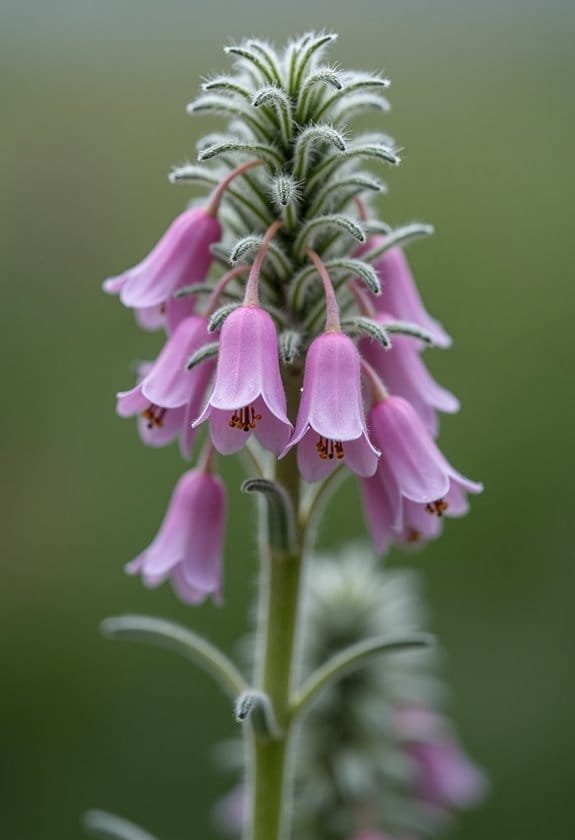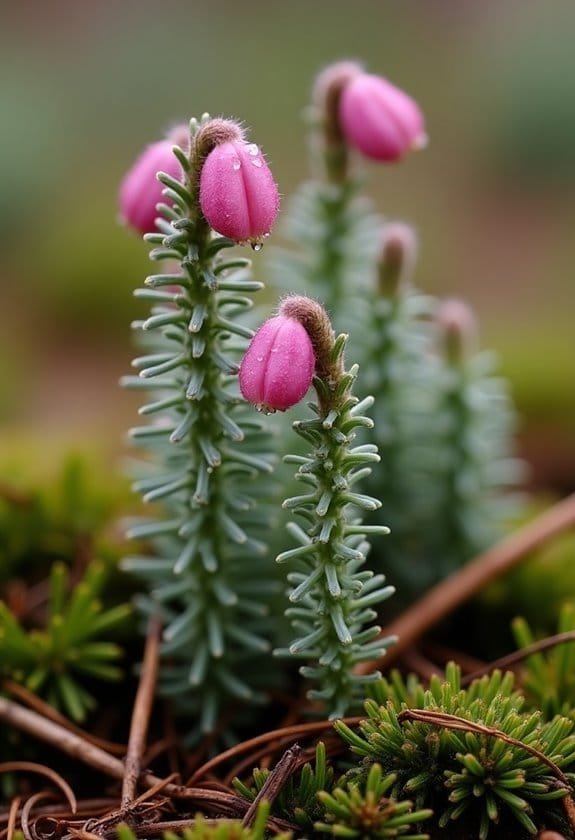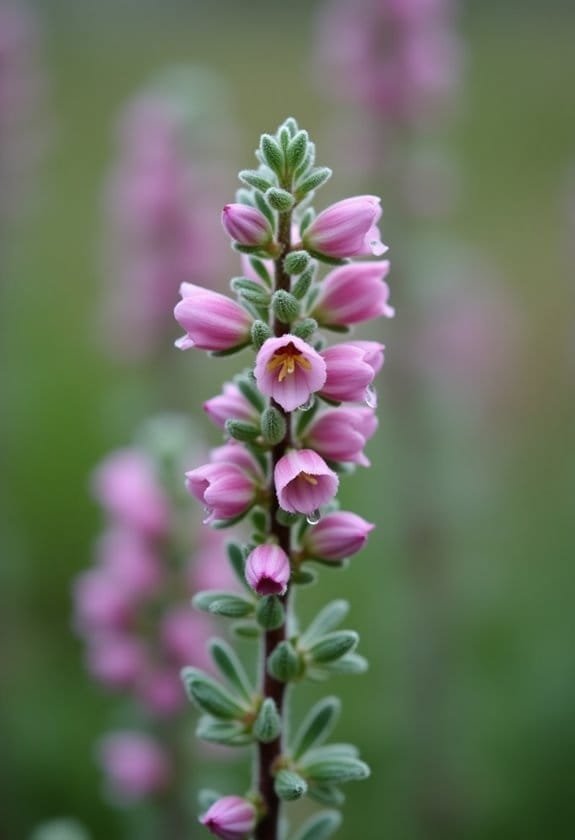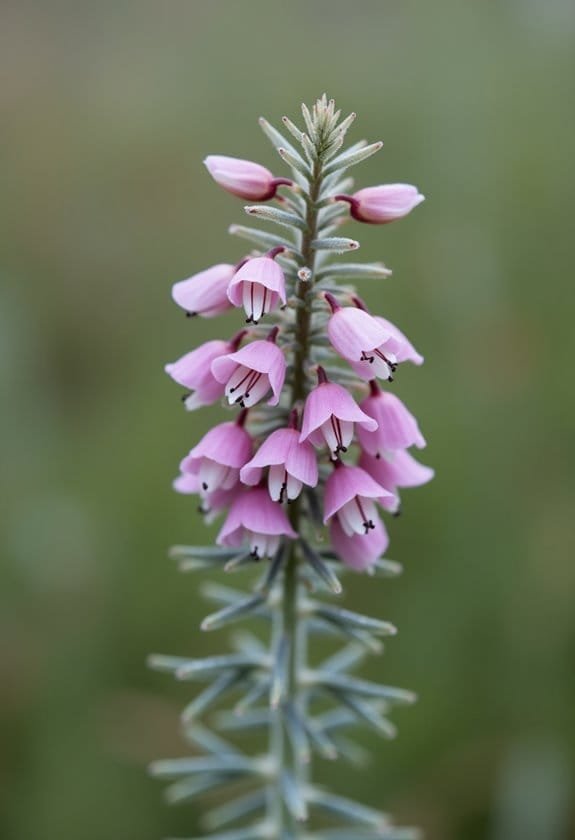Cross-leaved heath (Erica tetralix) is a distinctive evergreen shrub that grows 30-70cm tall in boggy heathlands across Europe. It's characterized by delicate pink bell-shaped flowers and unique whorls of four grey-green leaves arranged in a cross pattern, blooming from June through September. This member of the Ericaceae family thrives in acidic soils (pH 4.5-6.0) and serves as an essential nectar source for bees and moths while supporting broader ecosystem biodiversity. With its protocarnivorous traits and ability to form sterile hybrids, this resilient plant offers fascinating insights into botanical adaptations and evolutionary development.
Main Points
- Cross-leaved heath is a small shrub with pink bell-shaped flowers and grey-green leaves arranged in whorls of four.
- Found in acidic heathlands and bogs, it typically grows 30-70 cm tall and blooms from June through September.
- The plant requires well-drained, acidic soil with pH 4.5-6.0 and thrives in moist environments with full sun exposure.
- It serves as an important nectar source for pollinators and provides shelter for wildlife in moorland ecosystems.
- Regular maintenance includes consistent watering, post-flowering pruning, and protection from fungal infections and invasive species.
Introduction

Cross-leaved heath (*Erica tetralix*) stands as a distinctive member of the heather family, characterized by its delicate pink bell-shaped flowers and unique foliage arrangement.
The plant's most striking feature lies in its leaves, which emerge in whorls of four around its stems, creating a symmetrical pattern that sets it apart from its close relatives.
This perennial subshrub graces the boggy heathlands and wet moorlands of western Europe from June through September, where its drooping flower clusters provide essential nectar resources for local insect populations.
Common Name
Known widely as Cross-Leaved Heath, this delicate subshrub derives its common name from the distinctive arrangement of its leaves, which grow in whorls of four to form a cross-like pattern. This organized leaf structure serves as a defining characteristic, making the plant easily identifiable among other heath species in its native habitats.
The name "heath" itself reflects the plant's natural environment, as it thrives in acidic heathlands and boggy areas across the British landscape. Its presence has become so intrinsically linked to these ecosystems that it often serves as an indicator species for healthy moorland habitats.
Standing at a modest height of up to 30 centimeters, Cross-Leaved Heath creates dense clusters that provide valuable shelter for various wildlife species. The plant's pink, bell-shaped flowers, which grace the landscape from June through September, have earned it particular recognition among gardeners and naturalists alike.
These delicate blooms not only contribute to its ornamental appeal but also play a vital role in supporting local biodiversity by attracting numerous nectar-feeding insects to both wild and cultivated settings.
Scientific Name
The scientific name *Erica tetralix* stands out among the vast family of Ericaceae, perfectly capturing the plant's distinctive four-leaved arrangement through its specific epithet 'tetralix.' This binomial nomenclature, formally established within botanical taxonomy, reflects both the genus Erica, which encompasses numerous heath species, and its unique characteristic of having leaves arranged in whorls of four.
Like many acid-loving plants within its family, *Erica tetralix* demonstrates remarkable adaptability to challenging environments, particularly in wet heathlands and moorland ecosystems across western Europe.
The species' scientific classification has gained additional significance due to its protocarnivorous traits, evidenced by specialized sticky glands on its leaves and sepals.
The plant's taxonomic relationship with other heath species becomes particularly intriguing when examining its hybridization patterns.
*Erica tetralix* has demonstrated its genetic flexibility by forming sterile hybrids, including *Erica stuartii* and *Erica williamsii*, which further enriches our understanding of the species' evolutionary development and its position within the broader Ericaceae family classification system.
Overview
Among Europe's most distinctive heathland plants, *Erica tetralix* stands as a remarkable subshrub that graces wet moorlands with its delicate pink bell-shaped flowers and distinctive whorls of grey-green leaves.
This hardy perennial, reaching heights of up to 30 centimeters, displays its characteristic blooms from June through September, creating a stunning carpet of color across its preferred habitats.
The plant's most striking feature lies in its distinctive whorls of four narrow leaves, which set it apart from similar heath species found in western Europe.
*Erica tetralix* prefers acid bogs and damp coniferous woodlands, where its specialized adaptations allow it to thrive in challenging conditions.
Perhaps most intriguingly, the species exhibits protocarnivorous tendencies through its sticky glandular leaves and sepals, suggesting an evolutionary step toward carnivory.
The plant's ecological significance extends beyond its unique characteristics, as it attracts many nectar-loving insects, including bees and moths, making it an essential component of heathland ecosystems.
This intricate relationship between the cross-leaved heath and its pollinators highlights its critical role in maintaining biodiversity within its native range.
Key Features
Cross-leaved heath grows as a compact shrub reaching heights of up to 30 cm, distinguished by its characteristic whorls of four narrow, grey-green leaves with turned-under edges.
The plant's distinctive bell-shaped flowers, measuring 5-9 mm in length, bloom in dense clusters during the summer and autumn months from June through September.
These delicate blossoms undergo a remarkable transformation as they mature, shifting from rose-pink to orange hues, while their glandular hairy sepals curl outward at the edges.
Growth Size
Standing as a compact shrub in its natural habitat, cross-leaved heath reaches typical heights of 30 cm, though it can stretch up to 70 cm under ideal growing conditions. The plant's stature reflects its adaptation to challenging upland environments, where its modest height helps it withstand harsh weather conditions while establishing robust colonies in moist, acidic soils.
The growth pattern of this heath species is characterized by its distinctive whorls of leaves, which contribute considerably to its overall form and dimensions. Each stem supports narrow leaves measuring 2 to 5 mm in length, arranged in groups of four, creating a symmetrical appearance that defines the plant's structure.
These leaves undergo a remarkable transformation as they mature, beginning flat before developing their characteristic inrolled edges.
During the flowering period from June to September, the plant's architectural form is enhanced by clusters of pink, bell-shaped blooms that grace the stem tips. These floral displays, while delicate in appearance, are perfectly sized to complement the plant's compact growth habit, creating an aesthetically balanced natural structure.
Appearance
The distinctive appearance of Erica tetralix centers on its grey-green foliage arranged in precise whorls of four around each stem, creating its signature cross-shaped pattern. This type of heather showcases narrow leaves measuring 2 to 5 mm in length, with characteristically inrolled edges that give them a needle-like profile, while their surface bears a coating of short glandular hairs.
Perhaps most striking are the plant's delicate bell-shaped flowers, which cluster elegantly at the branch tips during its blooming period from June through September. These blossoms, measuring 5 to 9 mm in length, undergo a fascinating color transformation from rose-pink to orange as they mature.
The flowers display an interesting positional behavior, drooping gracefully during their blooming phase before turning upward as they evolve into fruit. Adding to its unique characteristics, the grey-green leaves and sepals feature sticky glands, suggesting potential protocarnivorous capabilities – an unusual trait that sets this heather apart from its relatives.
This combination of features creates a visually distinct and scientifically intriguing plant specimen.
Flowering Season
During peak summer months, spectacular displays of drooping pink bells announce the flowering season of Erica tetralix, which extends from late June through September. These diminutive flowers, measuring 5 to 9 millimeters in length, cluster together in compact formations at the stem tips, creating an enchanting sight across wet heath landscapes.
The flowering process showcases a remarkable change as the blossoms mature, shifting from their initial rose-pink hue to subtle orange tones before fruit development begins. Each flowering stem produces densely packed clusters that adopt a distinctive one-sided arrangement, contributing to the plant's characteristic appearance.
The bell-shaped blooms prove irresistible to various nectar-seeking insects, particularly bees and moths, which play vital roles in pollination.
The extended flowering period of cross-leaved heath provides a reliable source of nectar throughout the summer months, making it an indispensable component of heath ecosystems. Its consistent blooming pattern and abundant flower production guarantee sustained support for pollinator populations while creating vibrant patches of color across its native habitats.
Growing Requirements

Cross-leaved heath demands specific growing conditions to thrive, with its primary requirements centered on acidic, well-draining soil and abundant sunlight in open spaces.
The plant flourishes in consistently moist environments with humidity levels typical of upland areas and bogs, though it can withstand occasional dry spells without significant stress.
While adaptable to various temperature ranges, this heath species performs best when positioned in locations that receive full sun exposure throughout the growing season, allowing it to produce its characteristic pink-purple blooms.
Light
Ideal light conditions play a crucial role in the successful cultivation of cross-leaved heath. This striking plant demonstrates a marked preference for bright, unobstructed locations, where it can fully harness the sun's energy to produce its distinctive pink-purple flowers. In wet heath environments, the species thrives when exposed to full sunlight, which promotes robust growth and abundant blooming throughout its growing season.
While cross-leaved heath exhibits some adaptability to varying light conditions, its performance in shaded areas often falls short of its full capability. Plants growing in insufficient light tend to develop elongated, spindly stems and produce considerably fewer flowers, compromising both their ornamental value and ecological function.
The relationship between light exposure and plant vigor becomes particularly evident in the species' flowering patterns, as adequate sunlight directly correlates with nectar production and subsequent wildlife attraction. To maximize the plant's contribution to local ecosystems, gardeners and land managers should prioritize placement in open areas where it can receive ideal solar exposure, thereby supporting both the heath's health and its role as a valuable resource for pollinators.
Soil
Beyond light requirements, proper soil composition forms the foundation for successful cross-leaved heath cultivation. As a calcifuge species, this plant demonstrates a distinct preference for acidic soil conditions, specifically thriving in environments with pH levels between 4.5 and 6.0.
The plant's natural habitat in boggy regions and wet heaths provides essential clues for ideal growing conditions. Well-drained soils that maintain consistent moisture levels are vital for healthy development, though the plant can withstand brief periods of drought.
Gardeners should focus on creating a nutrient-poor environment that mirrors the plant's natural growing conditions, as excessive fertility can actually hinder its growth.
To maintain optimal growing conditions, incorporating organic mulch serves multiple purposes in cross-leaved heath cultivation. The mulch acts as a protective blanket, helping to retain essential soil moisture while gradually decomposing to enhance the soil's acidic properties.
This natural approach not only supports the plant's specific pH requirements but also creates a sustainable growing environment that closely resembles its native habitat conditions.
Water
Maintaining consistent moisture levels plays an essential role in the successful cultivation of cross-leaved heath. As an acid-loving plant that naturally occurs in bogs and wet heath environments, this species requires reliable access to water throughout its growing cycle, making it particularly well-suited for gardens with consistently damp conditions.
The plant's natural habitat preferences reflect its need for steady moisture, as it's commonly found thriving in boggy regions where water retention remains high throughout the year. While cross-leaved heath can withstand brief periods of reduced water availability, its ideal growth depends on maintaining dampness in the surrounding soil.
The species has evolved to flourish in areas where shallow water sources contribute to persistent soil moisture, creating perfect growing conditions that mirror its native environment. Gardeners should aim to replicate these natural conditions by ensuring regular watering practices, particularly during drier periods.
The combination of adequate moisture and acidic soil conditions creates the perfect microenvironment for this heath species, though it's worth noting that overwatering in poorly-draining soils should be avoided to prevent root issues.
Temperature
Throughout its growing cycle, cross-leaved heath displays remarkable adaptability to temperate climates, flourishing in temperatures between 15°C and 25°C (59°F to 77°F). This resilient plant has evolved to thrive in the mild conditions typical of western European uplands, where temperature fluctuations remain moderate throughout the seasons.
While the heath demonstrates impressive tolerance to varying conditions, it performs best in environments that maintain consistent temperatures without extreme variations. During winter months, the plant can withstand brief cold spells down to -5°C (23°F), though prolonged exposure to frost can greatly impact its health and blooming potential.
Like a delicate thermal balance, the plant's relationship with temperature intertwines closely with its moisture requirements, as it prefers cool, moist conditions that mirror its native habitat.
Gardeners cultivating this species should monitor temperature patterns carefully, particularly in regions prone to temperature extremes. Excessive heat can stress the plant and increase its moisture demands, while extended periods of freezing temperatures may necessitate additional protection to guarantee the heath's continued well-being and vibrant flowering cycles.
Pollinator Criteria
Cross-leaved heath's bell-shaped pink flowers serve as natural magnets for diverse pollinating insects, particularly bees and moths, during its peak flowering season from July through September.
The plant's distinctive drooping flower clusters create an ideal landing platform for these essential pollinators, while its specialized morphology guarantees efficient nectar access and pollen transfer.
The presence of sticky glands on both leaves and sepals may contribute to this intricate pollination strategy, suggesting an evolved mechanism that helps sustain local pollinator populations in heathland ecosystems.
Attracted Pollinators
The pink, bell-shaped flowers of Erica tetralix consistently attract diverse pollinating insects, particularly bees and moths, during its summer flowering period from July to September.
These delicate blooms, clustered at the shoot tips, serve as natural feeding stations in wet heath environments where the heather thrives.
The flowers' distinctive drooping characteristic plays an essential role in pollinator interactions, encouraging specific feeding behaviors that enhance successful pollination.
As pollinators navigate the compact flower clusters, they encounter an efficiently arranged nectar source that supports their dietary needs throughout the late summer months.
The plant's strategic presence in acid bogs and wet heathlands creates significant feeding opportunities for local pollinator populations.
While bees represent the primary daytime visitors, moths take advantage of these nectar-rich flowers during evening hours, ensuring continuous pollination throughout the day.
The presence of sticky glands on the plant's leaves and sepals adds another dimension to its insect interactions, suggesting potential protocarnivorous adaptations that may influence its relationships with smaller insects in its ecosystem.
Pollination Method
Natural pollination in Erica tetralix depends on specific criteria that enable successful reproduction. In wet heath or moorland habitats where these acid-loving plants thrive, the strategic positioning of their bell-shaped flowers creates a prime environment for pollinator interaction.
The plant's sophisticated pollination mechanism relies on how bees buzz from flower to flower across the heath, accessing nectar from the drooping blooms that gradually shift position as they mature. This evolutionary adaptation guarantees that pollinators can reach the reproductive structures at various stages of flower development.
The distinct arrangement of flowers in terminal clusters maximizes the efficiency of pollen transfer, while sticky glands on leaves and sepals may serve as additional attractants for visiting insects. During the peak flowering months between June and September, the synchronized timing of bloom with pollinator activity demonstrates the species' refined reproductive strategy.
Moths and bees, drawn to the pink inflorescences, move systematically through the flower clusters, facilitating cross-pollination as they transport pollen between individual plants across the heathland ecosystem.
Care & Maintenance

Cross-leaved heath demands careful attention to planting conditions, requiring acidic, well-drained soil and locations that mirror its natural boggy habitat.
Successful maintenance hinges on consistent watering schedules and post-flowering pruning, which encourages the development of compact, healthy growth patterns throughout the growing season.
The plant thrives when surrounded by compatible acid-loving companions like wintergreen and bog rosemary, while a protective mulch layer helps retain essential moisture and suppress unwanted vegetation.
Planting Tips
Successful cultivation of Cross-Leaved Heath depends on providing the right growing conditions and ongoing care. When planning to plant an ericaceous border, it's vital to select a location that receives ample sunlight while offering some protection from harsh afternoon rays.
The soil preparation is particularly important for these acid-loving plants, as they require well-drained, acidic conditions with a pH below 6.5.
To establish Cross-Leaved Heath successfully, dig a hole twice the width of the root ball and incorporate organic matter to improve drainage. Position the plant at the same depth it was growing in its container, taking care not to disturb the delicate root system.
After planting, water regularly to maintain consistent moisture levels, particularly during the establishment phase in the first growing season. Apply a generous layer of ericaceous mulch around the base, extending slightly beyond the plant's drip line, while keeping it away from the stem to prevent rot.
This mulch serves multiple purposes: it helps retain soil moisture, suppresses weed growth, and gradually breaks down to maintain the acidic conditions these heathers require.
Ongoing Care
Maintaining ideal growing conditions for Cross-Leaved Heath requires consistent attention to soil pH, moisture levels, and overall plant health. Gardeners must regularly monitor the acidity of the soil, as this heather species flourishes in distinctly acidic conditions that support its specialized root system.
The watering regimen should strike a careful balance, providing sufficient moisture while avoiding waterlogged conditions that could compromise root health. While Cross-Leaved Heath demonstrates admirable drought tolerance, consistent moisture helps maintain its characteristic compact growth pattern and vibrant foliage.
After the flowering period concludes, pruning becomes essential to promote dense growth and maintain an aesthetically pleasing form, with cuts made just below spent blooms.
Although this hardy plant typically thrives without supplemental nutrients, a springtime application of ericaceous fertilizer can boost performance in nutrient-poor soils.
To guarantee peak health, gardeners should maintain adequate spacing between plants, promoting air circulation that reduces the risk of fungal infections and pest infestations. Regular inspections for signs of stress or disease allow for early intervention when necessary.
Suggested Companions
Naturally compatible garden companions enhance the beauty and sustainability of cross-leaved heath plantings. Among the most harmonious companions are fellow acid-loving plants that thrive in the same challenging soil conditions, including rhododendrons, azaleas, and productive blueberry bushes.
Creating a community of heathers proves particularly successful, as species like Calluna vulgaris (common heather) and Erica cinerea (bell heather) share the same cultural requirements for wet heaths and acidic environments. These heather species collectively enhance biodiversity and provide valuable habitats for various insects, birds, and small mammals. Understanding heather plant identification and uses is essential for effective conservation and landscaping efforts, as they offer aesthetic appeal and ecological benefits. Additionally, their ability to thrive in nutrient-poor soils makes them an excellent choice for sustainable gardening and habitat restoration projects.
These plants form a tapestry of complementary textures and extended blooming periods throughout the growing season. When establishing companion plantings, it's crucial to maintain consistent moisture levels and incorporate acidic mulch, such as pine needles or bark, which benefits all plants in the grouping.
The mulch serves multiple purposes by retaining soil moisture, suppressing unwanted vegetation, and maintaining ideal pH levels for the entire planting area. Together, these carefully selected companions create a self-sustaining ecosystem that mirrors natural heathland communities, where each species contributes to the overall health and visual appeal of the garden space.
What Are the Key Differences Between Dorset Heath and Cross-Leaved Heath?
Dorset heath erica ciliaris is a rare plant species typically found in nutrient-poor soils. Unlike cross-leaved heath, which thrives in cooler, wetter regions and has whorls of four leaves, Dorset heath showcases distinctive bell-shaped flowers and thrives in warmer, sandy heathlands, often forming an essential part of its unique ecosystem.
Common Issues
Cross-leaved heath faces several notable challenges, including fungal infections that cause leaf discoloration and root rot in consistently waterlogged conditions.
Garden pests like aphids and spider mites can weaken the plant by feeding on its foliage, while competition from invasive species puts additional stress on established populations.
To combat these issues, gardeners should maintain proper drainage, monitor for early signs of infestation, and carefully remove competing vegetation without disturbing the heath's shallow root system.
Pests/Diseases
While many garden plants struggle with various ailments, the cross-leaved heath stands out for its natural resilience to pests and diseases. This hardy plant typically maintains robust health throughout its lifetime, though gardeners should remain vigilant for potential issues that may arise under specific conditions.
The most significant concern for cross-leaved heath is root rot, which can develop when the plant is subjected to waterlogged conditions. This underscores the essential importance of well-drained soil in maintaining the plant's health and well-being.
In humid environments, powdery mildew may occasionally appear on the foliage, manifesting as a whitish coating that can impede photosynthesis and affect overall plant vigor.
While occasional visits from aphids and spider mites occur, these pests rarely cause substantial damage to established plants. Regular monitoring and maintenance practices, including strategic pruning and the removal of dead plant material, serve as effective preventive measures against both pest infestations and disease outbreaks.
These simple yet important care strategies help guarantee the plant's continued resilience and healthy growth.
Solutions
Managing common issues with cross-leaved heath starts with proper soil preparation and maintenance. As one of many acid-loving plants, it requires well-drained, acidic conditions to thrive, and gardeners must avoid calcareous soils that can compromise its health.
When the wet conditions become excessive, implementing drainage solutions through raised beds or adding organic matter can help maintain ideal moisture levels.
To preserve the distinctive pink flowers that make this heath so appealing, regular management practices are essential. Conservation efforts should include controlled grazing and systematic scrub clearance to prevent competing vegetation from overwhelming the plants.
Hybridization concerns can be addressed by maintaining adequate spacing between different Erica species and monitoring plant populations for signs of genetic mixing. Local gardening groups can participate in conservation initiatives by creating dedicated areas for native heathland species, which helps preserve genetic diversity.
Additionally, implementing seasonal maintenance schedules, including careful pruning and soil pH monitoring, guarantees these delicate plants continue to flourish in their preferred habitat while supporting the broader ecosystem's biodiversity.
Summary

The distinctive pink-flowered *Erica tetralix*, commonly known as cross-leaved heath, is a low-growing subshrub native to western Europe's boggy regions and heathlands. This resilient plant, reaching heights of up to 30 centimeters, features characteristic grey-green leaves arranged in whorls of four along its branched stems.
From June through September, the plant's graceful bell-shaped blooms create an enthralling display, with drooping clusters of pink flowers adorning the stem tips. As an acid-loving plant, it flourishes in the challenging conditions of moorland environments, where it plays a significant ecological role by helping to attract nectar-loving insects.
The plant's ability to support local pollinators, particularly bees and moths, makes it an invaluable component of heathland ecosystems.
Horticultural enthusiasts have developed several notable varieties of cross-leaved heath, including the white-flowered *E. tetralix alba* and the distinctive *E. tetralix stellata*. These cultivars have earned recognition from the Royal Horticultural Society, demonstrating the species' adaptability from wild habitats to carefully cultivated garden settings.


